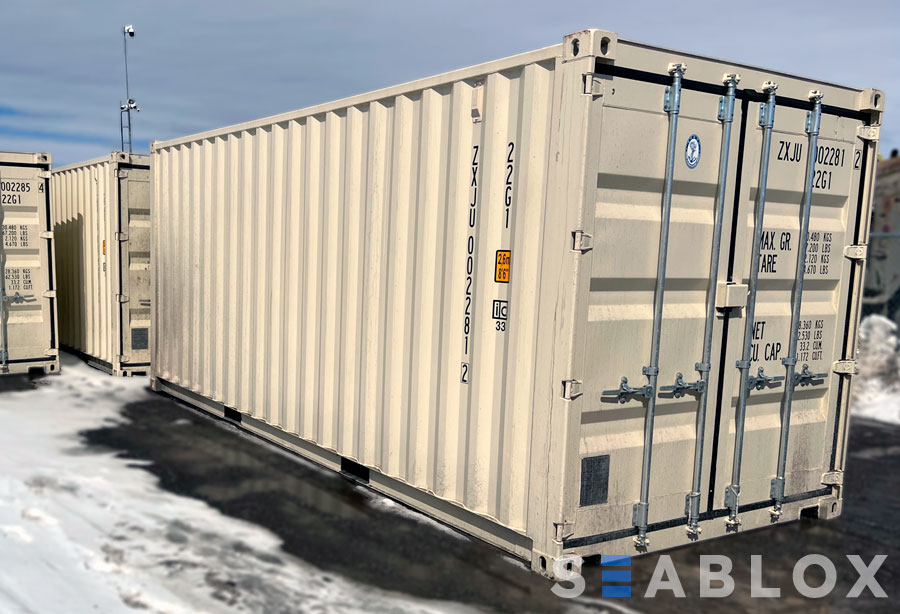In Ontario, shipping containers play a vital role across various industries, offering a reliable and secure means of transporting goods both domestically and internationally. Among these containers, the 20′ shipping container Ontario stands out as a cornerstone of modern logistics. Its versatility and standardized dimensions make it an industry favorite for efficiently moving large volumes of goods. As businesses in Ontario continue to rely on seamless logistics solutions, understanding the features and benefits of the 20′ shipping container becomes increasingly important.
| 20′ Standard Height | Dimensions |
|---|---|
| Internal Length | 5.9m / 19.4ft |
| Internal Width | 2.3m / 7.9ft |
| Internal Height | 2.3m / 7.9ft |
| External Length | 6.1m / 20ft |
| External Width | 2.44m / 8ft |
| External Height | 2.59m / 8.5ft |
| Tare Weight | 2,300kg / 5,071.5 lbs |
| Payload Capacity | 25,000kg / 55,126.9 lbs |
| Cubic Capacity | 33.2 m3 / 1,172 cu ft |
| 20′ High Cube | Dimensions |
|---|---|
| Internal Length | 5.9m / 19.4ft |
| Internal Width | 2.3m / 7.9ft |
| Internal Height | 2.70m / 8.10ft |
| External Length | 6.1m / 20ft |
| External Width | 2.44m / 8ft |
| External Height | 2.90m / 9.5ft |
| Tare Weight | 2,315 kgs / 5,103.7 lbs |
| Payload Capacity | 28,160 kg / 62,082.173 lbs |
| Cubic Capacity | 37.28 m³ / 1,335 cu ft |
Materials used in 20′ Shipping Container Construction
Most 20′ shipping containers are made from corten steel, a type of high-strength, low-alloy steel that is highly resistant to corrosion and weathering. The walls and roof of the container are typically constructed from corrugated steel panels, while the floor is made from marine-grade plywood or steel. The doors at one end of the container are equipped with locking mechanisms to ensure secure storage and transportation of goods.
The plywood flooring in a shipping container is designed to withstand heavy loads and repeated use. The thickness of the plywood varies depending on the manufacturer and intended use, but is typically around 28mm. The flooring is typically supported by cross members, which are welded to the underside of the container to distribute the weight of the cargo evenly.
Features of a 20′ Shipping Container:
- Forklift Pockets: Integrated pockets on the base of the container allow for easy lifting and transportation using forklifts, facilitating efficient loading and unloading.
- Barn Doors with Lockbox: Equipped with barn-style doors that swing outward, providing wide access for cargo loading and unloading. The inclusion of a lockbox ensures secure storage by offering added protection against unauthorized entry.
- Easy Open Door Handle: Designed with a user-friendly door handle mechanism, allowing for smooth and effortless opening and closing of the container doors, enhancing overall convenience during access.
- Vents: Fitted with vents to promote airflow within the container, helping to regulate temperature and prevent moisture buildup, which is crucial for maintaining the quality of stored goods and preventing condensation-related damage.
How many pallets can fit into a 20-foot container?
The number of pallets that can fit into a 20-foot container depends on the size of the pallets and the available space within the container. In general, a standard 20-foot container can hold up to 10 standard pallets in a single tier, with additional space for some smaller items or cartons on the floor.
However, it’s important to note that pallets come in different sizes, so the number of pallets that can fit into a container may vary depending on the dimensions of the pallets and the cargo being transported. It is crucial to consider the weight and dimensions of the cargo and pallets when determining how many can fit in a container to ensure that the maximum payload capacity and weight restrictions are not exceeded.
Furthermore, it is also important to consider the loading and unloading process. If the cargo requires a forklift or pallet jack to load or unload, it is important to leave enough space for maneuvering the equipment within the container. Therefore, it is recommended to work with a professional shipping company to determine the optimal loading and packing strategy for your cargo to ensure safe and efficient transportation.

